Human Resource Management Assignment
VerifiedAdded on 2020/11/12
|18
|5280
|38
AI Summary
This assignment requires a detailed analysis of various research studies and publications related to human resource management. It involves reviewing several books, journals, and online resources, highlighting key concepts and findings. The student is expected to demonstrate a thorough understanding of human resource management practices, employee engagement, and behavior, as well as the impact of corporate strategy on HRM. A summary of relevant research studies, including those by Bakker and Demerouti (2014), Jiang et al. (2012), and Kehoe and Wright (2013), is also required.
Contribute Materials
Your contribution can guide someone’s learning journey. Share your
documents today.
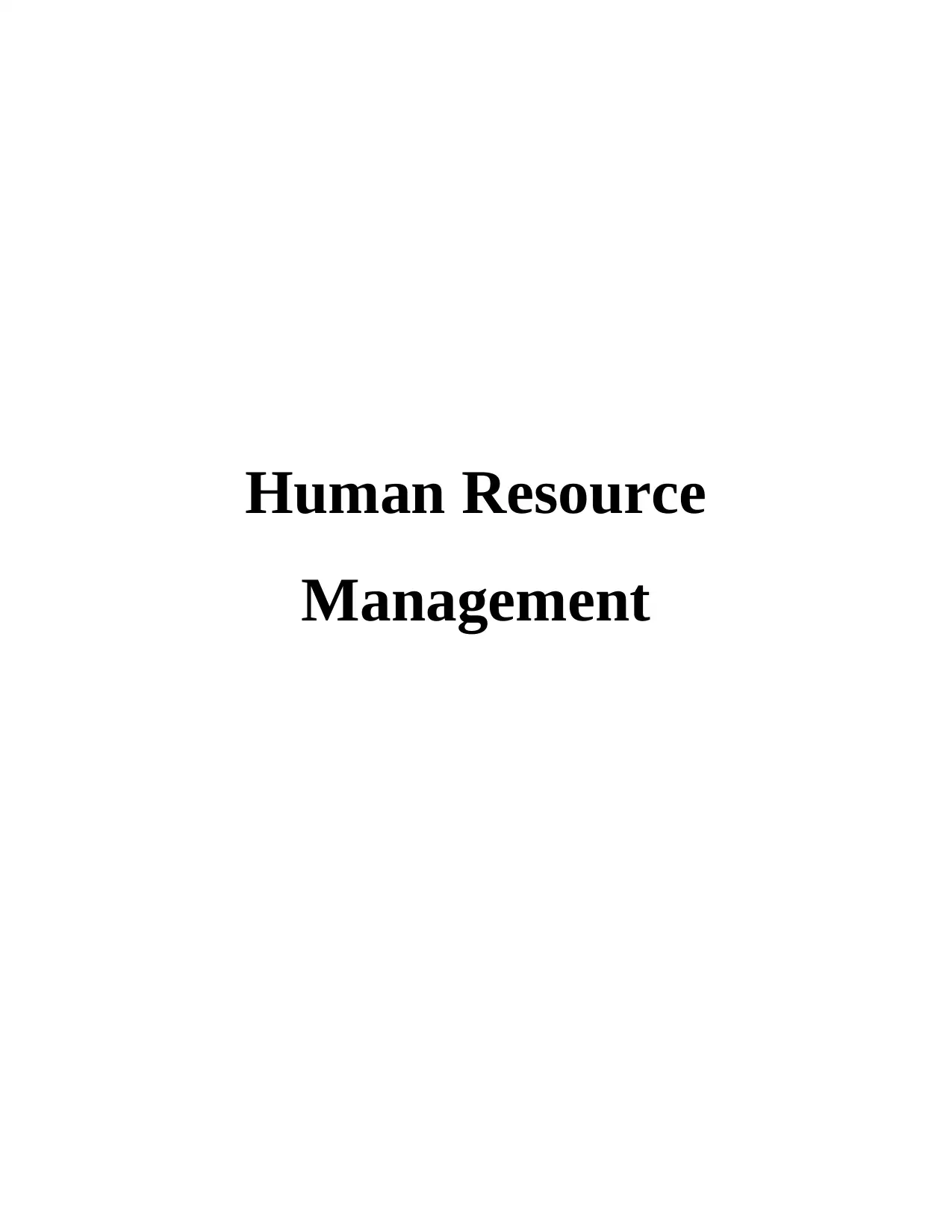
Human Resource
Management
Management
Secure Best Marks with AI Grader
Need help grading? Try our AI Grader for instant feedback on your assignments.

Table of Contents
INTRODUCTION...........................................................................................................................1
TASK 1............................................................................................................................................1
1. The purpose of the HR function and the key roles and responsibilities of HR functions.......1
2. The approaches of workforce planning, recruitment & selection, Training & development..2
3.Case study example to examine the different methods used in HR practices.........................4
4. Effectiveness of employee relation and employee engagement with mention of the flexible
organisation.................................................................................................................................4
5. Key aspects of employment legislation...................................................................................5
6. Evaluation of employee relation and employment legislation inform decision making and
meets business objectives............................................................................................................6
TASK 2............................................................................................................................................7
7. The application of HRM practices in work related context....................................................7
8. Evaluate the use of technology, online resources, digital platforms and social networking or
improving the recruitment and selection process........................................................................7
CONCLUSIONS..............................................................................................................................7
REFERENCES................................................................................................................................8
INTRODUCTION...........................................................................................................................1
TASK 1............................................................................................................................................1
1. The purpose of the HR function and the key roles and responsibilities of HR functions.......1
2. The approaches of workforce planning, recruitment & selection, Training & development..2
3.Case study example to examine the different methods used in HR practices.........................4
4. Effectiveness of employee relation and employee engagement with mention of the flexible
organisation.................................................................................................................................4
5. Key aspects of employment legislation...................................................................................5
6. Evaluation of employee relation and employment legislation inform decision making and
meets business objectives............................................................................................................6
TASK 2............................................................................................................................................7
7. The application of HRM practices in work related context....................................................7
8. Evaluate the use of technology, online resources, digital platforms and social networking or
improving the recruitment and selection process........................................................................7
CONCLUSIONS..............................................................................................................................7
REFERENCES................................................................................................................................8
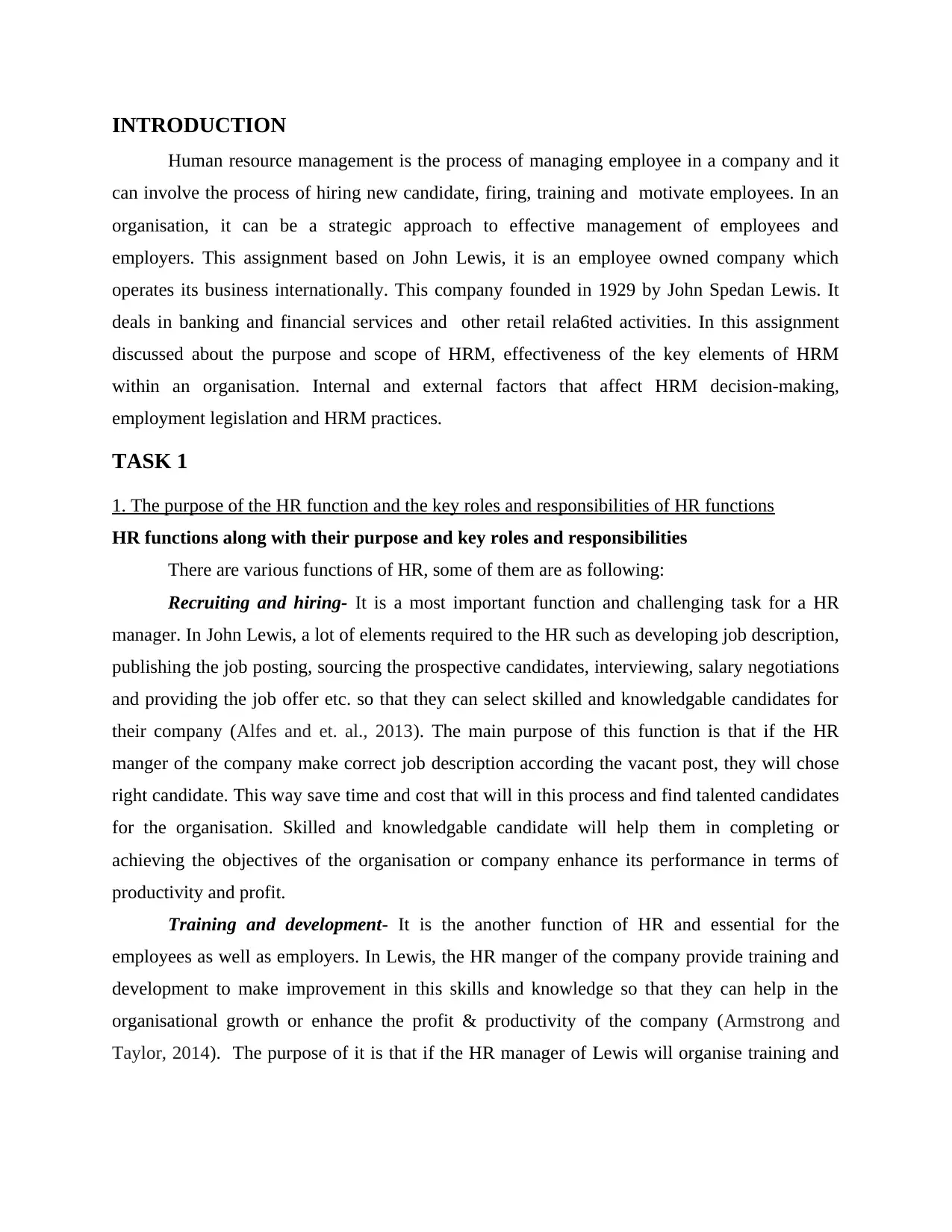
INTRODUCTION
Human resource management is the process of managing employee in a company and it
can involve the process of hiring new candidate, firing, training and motivate employees. In an
organisation, it can be a strategic approach to effective management of employees and
employers. This assignment based on John Lewis, it is an employee owned company which
operates its business internationally. This company founded in 1929 by John Spedan Lewis. It
deals in banking and financial services and other retail rela6ted activities. In this assignment
discussed about the purpose and scope of HRM, effectiveness of the key elements of HRM
within an organisation. Internal and external factors that affect HRM decision-making,
employment legislation and HRM practices.
TASK 1
1. The purpose of the HR function and the key roles and responsibilities of HR functions
HR functions along with their purpose and key roles and responsibilities
There are various functions of HR, some of them are as following:
Recruiting and hiring- It is a most important function and challenging task for a HR
manager. In John Lewis, a lot of elements required to the HR such as developing job description,
publishing the job posting, sourcing the prospective candidates, interviewing, salary negotiations
and providing the job offer etc. so that they can select skilled and knowledgable candidates for
their company (Alfes and et. al., 2013). The main purpose of this function is that if the HR
manger of the company make correct job description according the vacant post, they will chose
right candidate. This way save time and cost that will in this process and find talented candidates
for the organisation. Skilled and knowledgable candidate will help them in completing or
achieving the objectives of the organisation or company enhance its performance in terms of
productivity and profit.
Training and development- It is the another function of HR and essential for the
employees as well as employers. In Lewis, the HR manger of the company provide training and
development to make improvement in this skills and knowledge so that they can help in the
organisational growth or enhance the profit & productivity of the company (Armstrong and
Taylor, 2014). The purpose of it is that if the HR manager of Lewis will organise training and
Human resource management is the process of managing employee in a company and it
can involve the process of hiring new candidate, firing, training and motivate employees. In an
organisation, it can be a strategic approach to effective management of employees and
employers. This assignment based on John Lewis, it is an employee owned company which
operates its business internationally. This company founded in 1929 by John Spedan Lewis. It
deals in banking and financial services and other retail rela6ted activities. In this assignment
discussed about the purpose and scope of HRM, effectiveness of the key elements of HRM
within an organisation. Internal and external factors that affect HRM decision-making,
employment legislation and HRM practices.
TASK 1
1. The purpose of the HR function and the key roles and responsibilities of HR functions
HR functions along with their purpose and key roles and responsibilities
There are various functions of HR, some of them are as following:
Recruiting and hiring- It is a most important function and challenging task for a HR
manager. In John Lewis, a lot of elements required to the HR such as developing job description,
publishing the job posting, sourcing the prospective candidates, interviewing, salary negotiations
and providing the job offer etc. so that they can select skilled and knowledgable candidates for
their company (Alfes and et. al., 2013). The main purpose of this function is that if the HR
manger of the company make correct job description according the vacant post, they will chose
right candidate. This way save time and cost that will in this process and find talented candidates
for the organisation. Skilled and knowledgable candidate will help them in completing or
achieving the objectives of the organisation or company enhance its performance in terms of
productivity and profit.
Training and development- It is the another function of HR and essential for the
employees as well as employers. In Lewis, the HR manger of the company provide training and
development to make improvement in this skills and knowledge so that they can help in the
organisational growth or enhance the profit & productivity of the company (Armstrong and
Taylor, 2014). The purpose of it is that if the HR manager of Lewis will organise training and
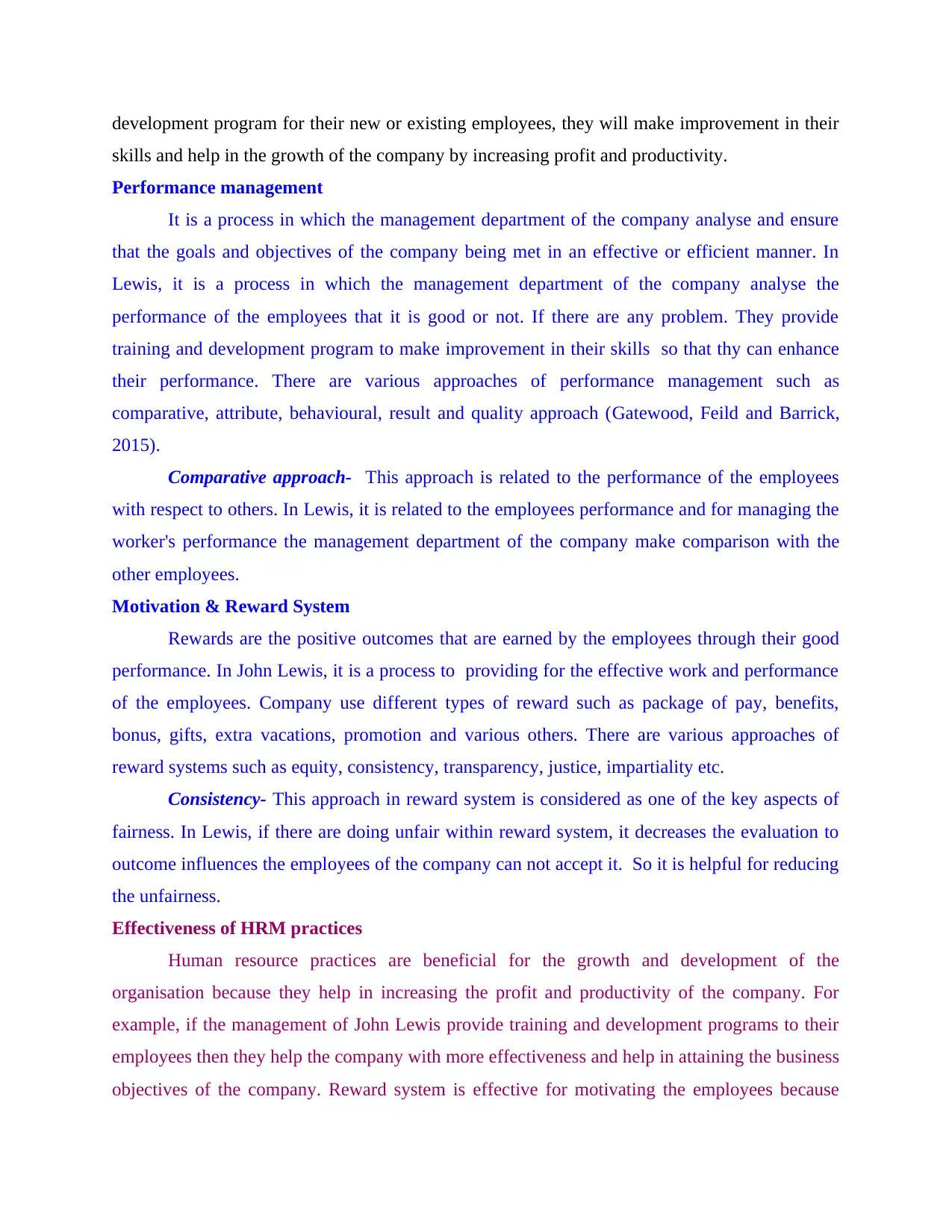
development program for their new or existing employees, they will make improvement in their
skills and help in the growth of the company by increasing profit and productivity.
Performance management
It is a process in which the management department of the company analyse and ensure
that the goals and objectives of the company being met in an effective or efficient manner. In
Lewis, it is a process in which the management department of the company analyse the
performance of the employees that it is good or not. If there are any problem. They provide
training and development program to make improvement in their skills so that thy can enhance
their performance. There are various approaches of performance management such as
comparative, attribute, behavioural, result and quality approach (Gatewood, Feild and Barrick,
2015).
Comparative approach- This approach is related to the performance of the employees
with respect to others. In Lewis, it is related to the employees performance and for managing the
worker's performance the management department of the company make comparison with the
other employees.
Motivation & Reward System
Rewards are the positive outcomes that are earned by the employees through their good
performance. In John Lewis, it is a process to providing for the effective work and performance
of the employees. Company use different types of reward such as package of pay, benefits,
bonus, gifts, extra vacations, promotion and various others. There are various approaches of
reward systems such as equity, consistency, transparency, justice, impartiality etc.
Consistency- This approach in reward system is considered as one of the key aspects of
fairness. In Lewis, if there are doing unfair within reward system, it decreases the evaluation to
outcome influences the employees of the company can not accept it. So it is helpful for reducing
the unfairness.
Effectiveness of HRM practices
Human resource practices are beneficial for the growth and development of the
organisation because they help in increasing the profit and productivity of the company. For
example, if the management of John Lewis provide training and development programs to their
employees then they help the company with more effectiveness and help in attaining the business
objectives of the company. Reward system is effective for motivating the employees because
skills and help in the growth of the company by increasing profit and productivity.
Performance management
It is a process in which the management department of the company analyse and ensure
that the goals and objectives of the company being met in an effective or efficient manner. In
Lewis, it is a process in which the management department of the company analyse the
performance of the employees that it is good or not. If there are any problem. They provide
training and development program to make improvement in their skills so that thy can enhance
their performance. There are various approaches of performance management such as
comparative, attribute, behavioural, result and quality approach (Gatewood, Feild and Barrick,
2015).
Comparative approach- This approach is related to the performance of the employees
with respect to others. In Lewis, it is related to the employees performance and for managing the
worker's performance the management department of the company make comparison with the
other employees.
Motivation & Reward System
Rewards are the positive outcomes that are earned by the employees through their good
performance. In John Lewis, it is a process to providing for the effective work and performance
of the employees. Company use different types of reward such as package of pay, benefits,
bonus, gifts, extra vacations, promotion and various others. There are various approaches of
reward systems such as equity, consistency, transparency, justice, impartiality etc.
Consistency- This approach in reward system is considered as one of the key aspects of
fairness. In Lewis, if there are doing unfair within reward system, it decreases the evaluation to
outcome influences the employees of the company can not accept it. So it is helpful for reducing
the unfairness.
Effectiveness of HRM practices
Human resource practices are beneficial for the growth and development of the
organisation because they help in increasing the profit and productivity of the company. For
example, if the management of John Lewis provide training and development programs to their
employees then they help the company with more effectiveness and help in attaining the business
objectives of the company. Reward system is effective for motivating the employees because
Paraphrase This Document
Need a fresh take? Get an instant paraphrase of this document with our AI Paraphraser
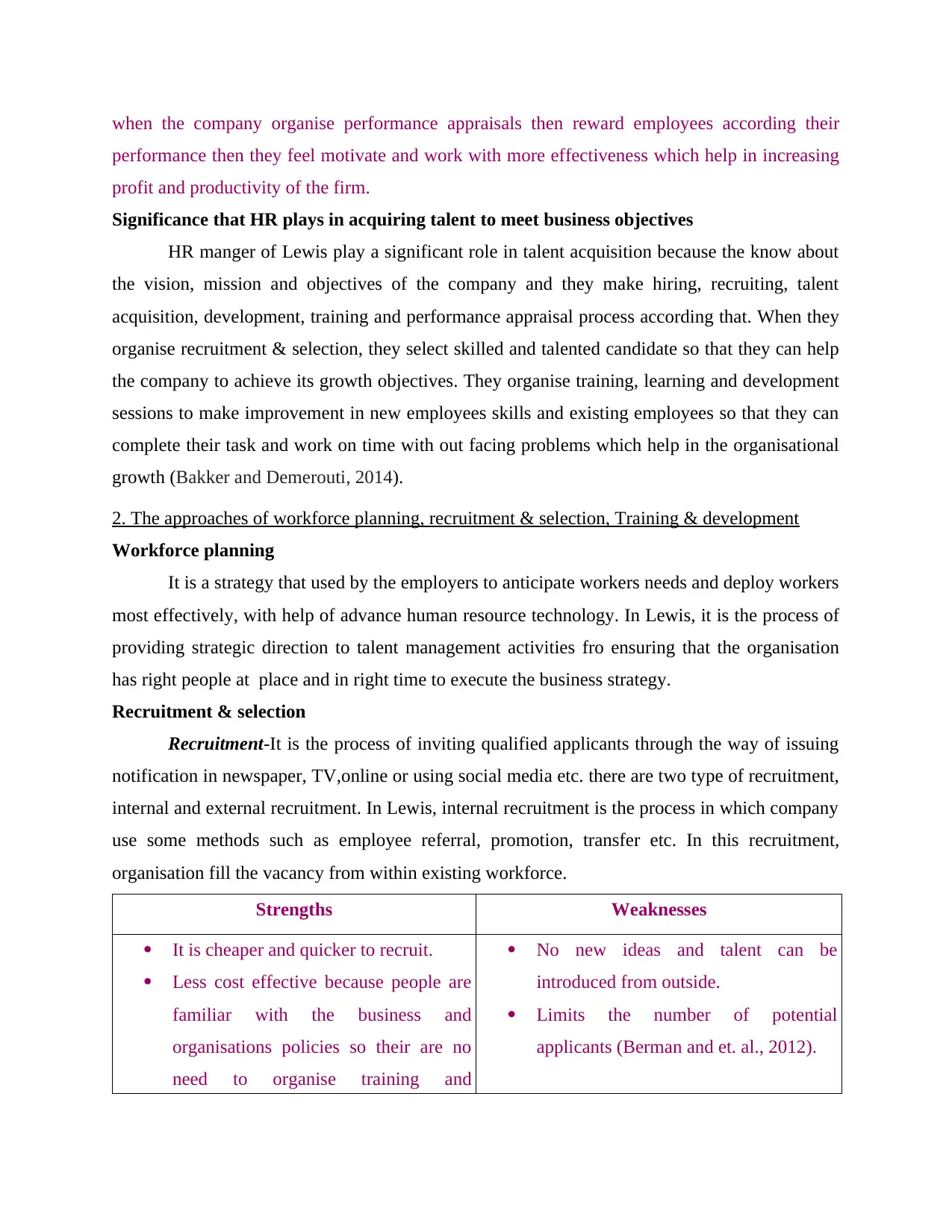
when the company organise performance appraisals then reward employees according their
performance then they feel motivate and work with more effectiveness which help in increasing
profit and productivity of the firm.
Significance that HR plays in acquiring talent to meet business objectives
HR manger of Lewis play a significant role in talent acquisition because the know about
the vision, mission and objectives of the company and they make hiring, recruiting, talent
acquisition, development, training and performance appraisal process according that. When they
organise recruitment & selection, they select skilled and talented candidate so that they can help
the company to achieve its growth objectives. They organise training, learning and development
sessions to make improvement in new employees skills and existing employees so that they can
complete their task and work on time with out facing problems which help in the organisational
growth (Bakker and Demerouti, 2014).
2. The approaches of workforce planning, recruitment & selection, Training & development
Workforce planning
It is a strategy that used by the employers to anticipate workers needs and deploy workers
most effectively, with help of advance human resource technology. In Lewis, it is the process of
providing strategic direction to talent management activities fro ensuring that the organisation
has right people at place and in right time to execute the business strategy.
Recruitment & selection
Recruitment-It is the process of inviting qualified applicants through the way of issuing
notification in newspaper, TV,online or using social media etc. there are two type of recruitment,
internal and external recruitment. In Lewis, internal recruitment is the process in which company
use some methods such as employee referral, promotion, transfer etc. In this recruitment,
organisation fill the vacancy from within existing workforce.
Strengths Weaknesses
It is cheaper and quicker to recruit.
Less cost effective because people are
familiar with the business and
organisations policies so their are no
need to organise training and
No new ideas and talent can be
introduced from outside.
Limits the number of potential
applicants (Berman and et. al., 2012).
performance then they feel motivate and work with more effectiveness which help in increasing
profit and productivity of the firm.
Significance that HR plays in acquiring talent to meet business objectives
HR manger of Lewis play a significant role in talent acquisition because the know about
the vision, mission and objectives of the company and they make hiring, recruiting, talent
acquisition, development, training and performance appraisal process according that. When they
organise recruitment & selection, they select skilled and talented candidate so that they can help
the company to achieve its growth objectives. They organise training, learning and development
sessions to make improvement in new employees skills and existing employees so that they can
complete their task and work on time with out facing problems which help in the organisational
growth (Bakker and Demerouti, 2014).
2. The approaches of workforce planning, recruitment & selection, Training & development
Workforce planning
It is a strategy that used by the employers to anticipate workers needs and deploy workers
most effectively, with help of advance human resource technology. In Lewis, it is the process of
providing strategic direction to talent management activities fro ensuring that the organisation
has right people at place and in right time to execute the business strategy.
Recruitment & selection
Recruitment-It is the process of inviting qualified applicants through the way of issuing
notification in newspaper, TV,online or using social media etc. there are two type of recruitment,
internal and external recruitment. In Lewis, internal recruitment is the process in which company
use some methods such as employee referral, promotion, transfer etc. In this recruitment,
organisation fill the vacancy from within existing workforce.
Strengths Weaknesses
It is cheaper and quicker to recruit.
Less cost effective because people are
familiar with the business and
organisations policies so their are no
need to organise training and
No new ideas and talent can be
introduced from outside.
Limits the number of potential
applicants (Berman and et. al., 2012).

development session.
External recruitment is the process of inviting job applicants who do not belong from
company. Lewis used various methods for this kind of recruitment such as giving advertisement
or notification through newspaper, TV, radio, Facebook, Instagram, social media and others
(Bratton and Gold, 2017).
Strengths Weaknesses
New skills and talent are introduced
with the organisation.
Number of potential applicants and best
qualified ones can chosen easily
according to the vacant position.
It is more cost and time effective
process because there are unaware
people and training and orientation
session are organised for them to
provide needed information.
There are high chances of wrong
selection.
So the external recruitment is good for the company because with the help of this method
the management for company can find out skilled and talented candidate outside the company
and they help in the growth of the firm.
Selection- It the process of interviewing and evaluating the candidates and applicants for
a specific job position. In Lewis, it can be a process of selecting candidates according certain
criteria that are set by the company for their recruitment and selection process. There are various
methods that can be use by the company to chose candidates such as interview, aptitude test,
ability test etc.
Strengths Weaknesses
Complete and correct information or
details can be gathered easily about the
candidates.
Ease of comparison for employers.
It is an cost and time consuming
process.
The personal detail can be fall in to
wrong hands.
In this organisation, the management of the company can follow and use interview
method of selection to hire a candidate. Because it is an effective and efficient method and with
the help it the management can get required information by face to face communication and get
correct information.
External recruitment is the process of inviting job applicants who do not belong from
company. Lewis used various methods for this kind of recruitment such as giving advertisement
or notification through newspaper, TV, radio, Facebook, Instagram, social media and others
(Bratton and Gold, 2017).
Strengths Weaknesses
New skills and talent are introduced
with the organisation.
Number of potential applicants and best
qualified ones can chosen easily
according to the vacant position.
It is more cost and time effective
process because there are unaware
people and training and orientation
session are organised for them to
provide needed information.
There are high chances of wrong
selection.
So the external recruitment is good for the company because with the help of this method
the management for company can find out skilled and talented candidate outside the company
and they help in the growth of the firm.
Selection- It the process of interviewing and evaluating the candidates and applicants for
a specific job position. In Lewis, it can be a process of selecting candidates according certain
criteria that are set by the company for their recruitment and selection process. There are various
methods that can be use by the company to chose candidates such as interview, aptitude test,
ability test etc.
Strengths Weaknesses
Complete and correct information or
details can be gathered easily about the
candidates.
Ease of comparison for employers.
It is an cost and time consuming
process.
The personal detail can be fall in to
wrong hands.
In this organisation, the management of the company can follow and use interview
method of selection to hire a candidate. Because it is an effective and efficient method and with
the help it the management can get required information by face to face communication and get
correct information.
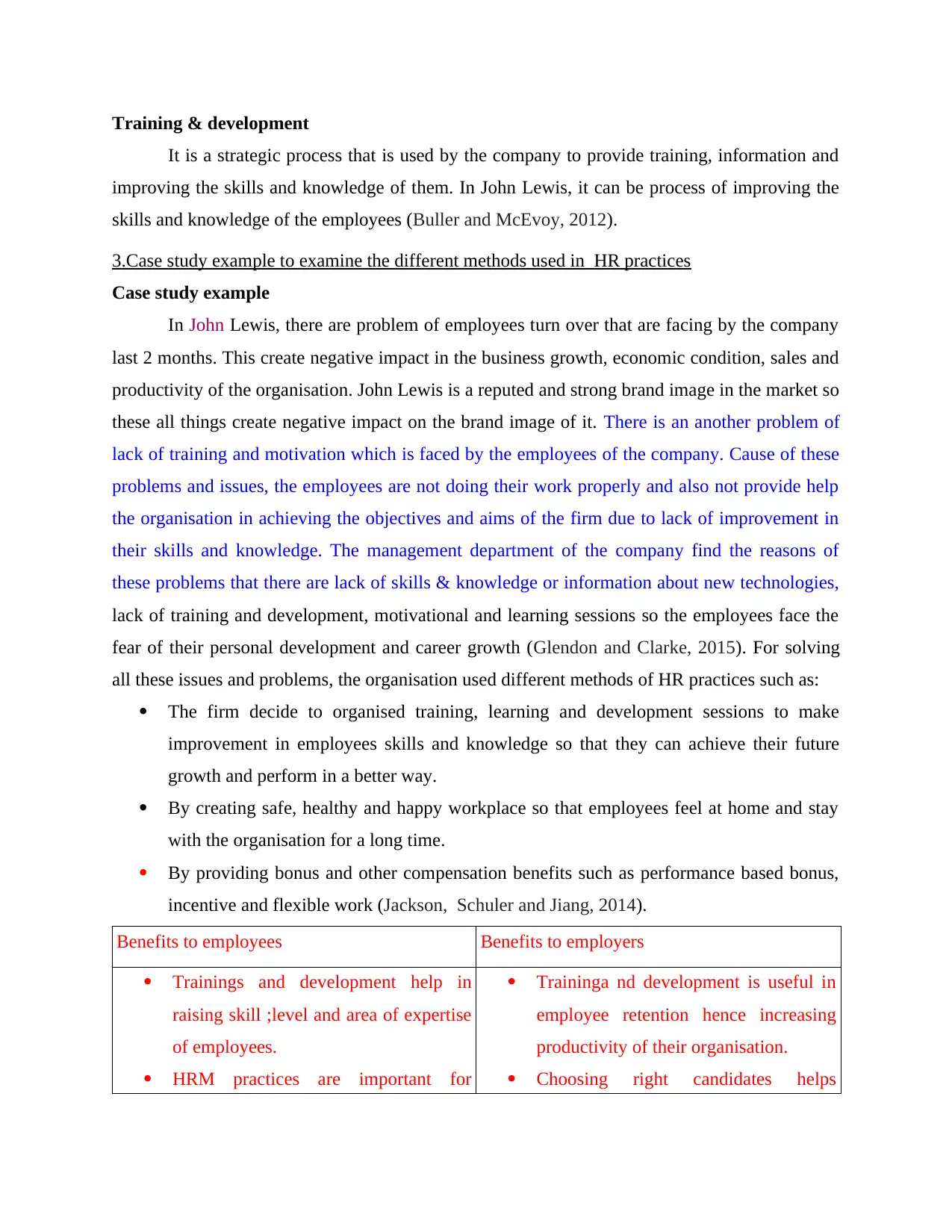
Training & development
It is a strategic process that is used by the company to provide training, information and
improving the skills and knowledge of them. In John Lewis, it can be process of improving the
skills and knowledge of the employees (Buller and McEvoy, 2012).
3.Case study example to examine the different methods used in HR practices
Case study example
In John Lewis, there are problem of employees turn over that are facing by the company
last 2 months. This create negative impact in the business growth, economic condition, sales and
productivity of the organisation. John Lewis is a reputed and strong brand image in the market so
these all things create negative impact on the brand image of it. There is an another problem of
lack of training and motivation which is faced by the employees of the company. Cause of these
problems and issues, the employees are not doing their work properly and also not provide help
the organisation in achieving the objectives and aims of the firm due to lack of improvement in
their skills and knowledge. The management department of the company find the reasons of
these problems that there are lack of skills & knowledge or information about new technologies,
lack of training and development, motivational and learning sessions so the employees face the
fear of their personal development and career growth (Glendon and Clarke, 2015). For solving
all these issues and problems, the organisation used different methods of HR practices such as:
The firm decide to organised training, learning and development sessions to make
improvement in employees skills and knowledge so that they can achieve their future
growth and perform in a better way.
By creating safe, healthy and happy workplace so that employees feel at home and stay
with the organisation for a long time.
By providing bonus and other compensation benefits such as performance based bonus,
incentive and flexible work (Jackson, Schuler and Jiang, 2014).
Benefits to employees Benefits to employers
Trainings and development help in
raising skill ;level and area of expertise
of employees.
HRM practices are important for
Traininga nd development is useful in
employee retention hence increasing
productivity of their organisation.
Choosing right candidates helps
It is a strategic process that is used by the company to provide training, information and
improving the skills and knowledge of them. In John Lewis, it can be process of improving the
skills and knowledge of the employees (Buller and McEvoy, 2012).
3.Case study example to examine the different methods used in HR practices
Case study example
In John Lewis, there are problem of employees turn over that are facing by the company
last 2 months. This create negative impact in the business growth, economic condition, sales and
productivity of the organisation. John Lewis is a reputed and strong brand image in the market so
these all things create negative impact on the brand image of it. There is an another problem of
lack of training and motivation which is faced by the employees of the company. Cause of these
problems and issues, the employees are not doing their work properly and also not provide help
the organisation in achieving the objectives and aims of the firm due to lack of improvement in
their skills and knowledge. The management department of the company find the reasons of
these problems that there are lack of skills & knowledge or information about new technologies,
lack of training and development, motivational and learning sessions so the employees face the
fear of their personal development and career growth (Glendon and Clarke, 2015). For solving
all these issues and problems, the organisation used different methods of HR practices such as:
The firm decide to organised training, learning and development sessions to make
improvement in employees skills and knowledge so that they can achieve their future
growth and perform in a better way.
By creating safe, healthy and happy workplace so that employees feel at home and stay
with the organisation for a long time.
By providing bonus and other compensation benefits such as performance based bonus,
incentive and flexible work (Jackson, Schuler and Jiang, 2014).
Benefits to employees Benefits to employers
Trainings and development help in
raising skill ;level and area of expertise
of employees.
HRM practices are important for
Traininga nd development is useful in
employee retention hence increasing
productivity of their organisation.
Choosing right candidates helps
Secure Best Marks with AI Grader
Need help grading? Try our AI Grader for instant feedback on your assignments.
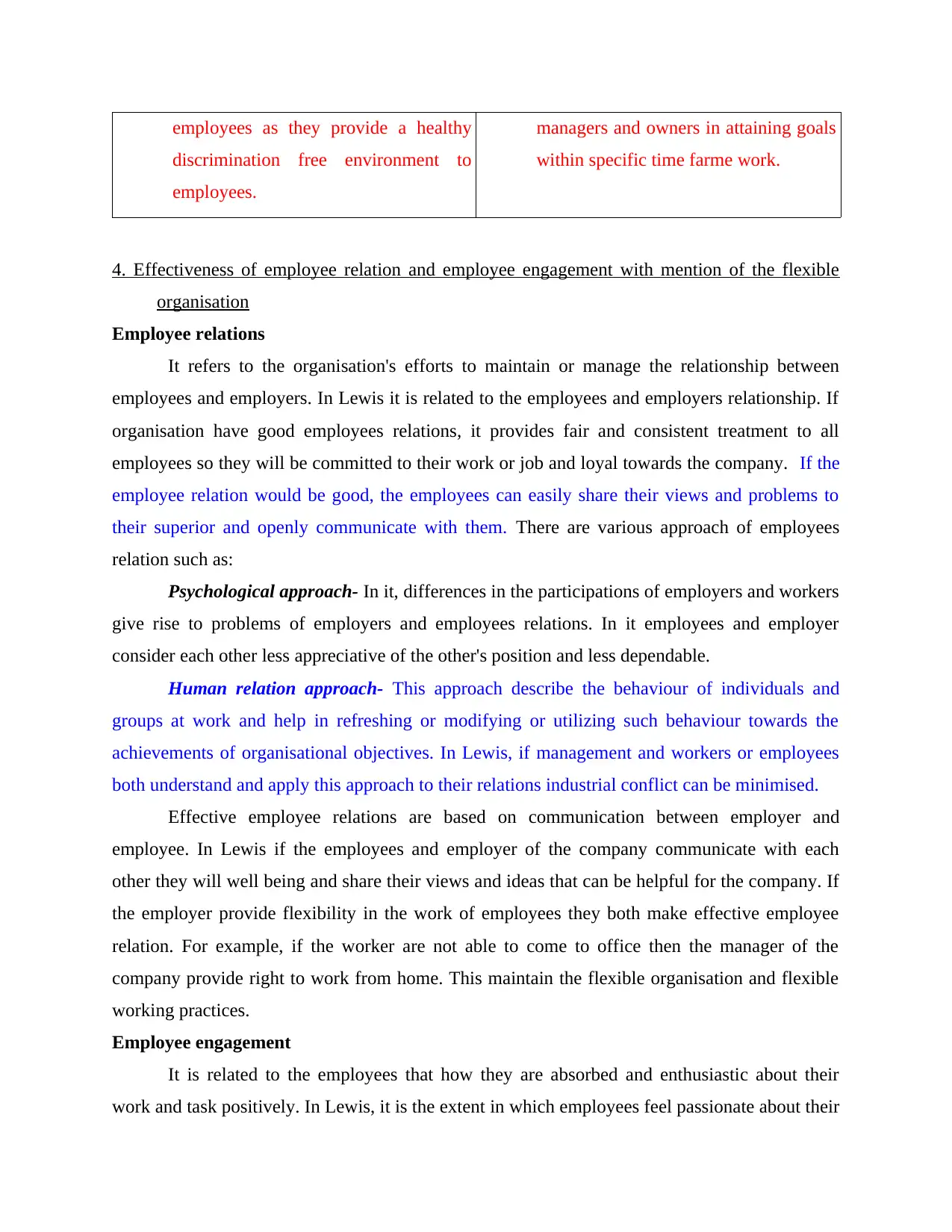
employees as they provide a healthy
discrimination free environment to
employees.
managers and owners in attaining goals
within specific time farme work.
4. Effectiveness of employee relation and employee engagement with mention of the flexible
organisation
Employee relations
It refers to the organisation's efforts to maintain or manage the relationship between
employees and employers. In Lewis it is related to the employees and employers relationship. If
organisation have good employees relations, it provides fair and consistent treatment to all
employees so they will be committed to their work or job and loyal towards the company. If the
employee relation would be good, the employees can easily share their views and problems to
their superior and openly communicate with them. There are various approach of employees
relation such as:
Psychological approach- In it, differences in the participations of employers and workers
give rise to problems of employers and employees relations. In it employees and employer
consider each other less appreciative of the other's position and less dependable.
Human relation approach- This approach describe the behaviour of individuals and
groups at work and help in refreshing or modifying or utilizing such behaviour towards the
achievements of organisational objectives. In Lewis, if management and workers or employees
both understand and apply this approach to their relations industrial conflict can be minimised.
Effective employee relations are based on communication between employer and
employee. In Lewis if the employees and employer of the company communicate with each
other they will well being and share their views and ideas that can be helpful for the company. If
the employer provide flexibility in the work of employees they both make effective employee
relation. For example, if the worker are not able to come to office then the manager of the
company provide right to work from home. This maintain the flexible organisation and flexible
working practices.
Employee engagement
It is related to the employees that how they are absorbed and enthusiastic about their
work and task positively. In Lewis, it is the extent in which employees feel passionate about their
discrimination free environment to
employees.
managers and owners in attaining goals
within specific time farme work.
4. Effectiveness of employee relation and employee engagement with mention of the flexible
organisation
Employee relations
It refers to the organisation's efforts to maintain or manage the relationship between
employees and employers. In Lewis it is related to the employees and employers relationship. If
organisation have good employees relations, it provides fair and consistent treatment to all
employees so they will be committed to their work or job and loyal towards the company. If the
employee relation would be good, the employees can easily share their views and problems to
their superior and openly communicate with them. There are various approach of employees
relation such as:
Psychological approach- In it, differences in the participations of employers and workers
give rise to problems of employers and employees relations. In it employees and employer
consider each other less appreciative of the other's position and less dependable.
Human relation approach- This approach describe the behaviour of individuals and
groups at work and help in refreshing or modifying or utilizing such behaviour towards the
achievements of organisational objectives. In Lewis, if management and workers or employees
both understand and apply this approach to their relations industrial conflict can be minimised.
Effective employee relations are based on communication between employer and
employee. In Lewis if the employees and employer of the company communicate with each
other they will well being and share their views and ideas that can be helpful for the company. If
the employer provide flexibility in the work of employees they both make effective employee
relation. For example, if the worker are not able to come to office then the manager of the
company provide right to work from home. This maintain the flexible organisation and flexible
working practices.
Employee engagement
It is related to the employees that how they are absorbed and enthusiastic about their
work and task positively. In Lewis, it is the extent in which employees feel passionate about their
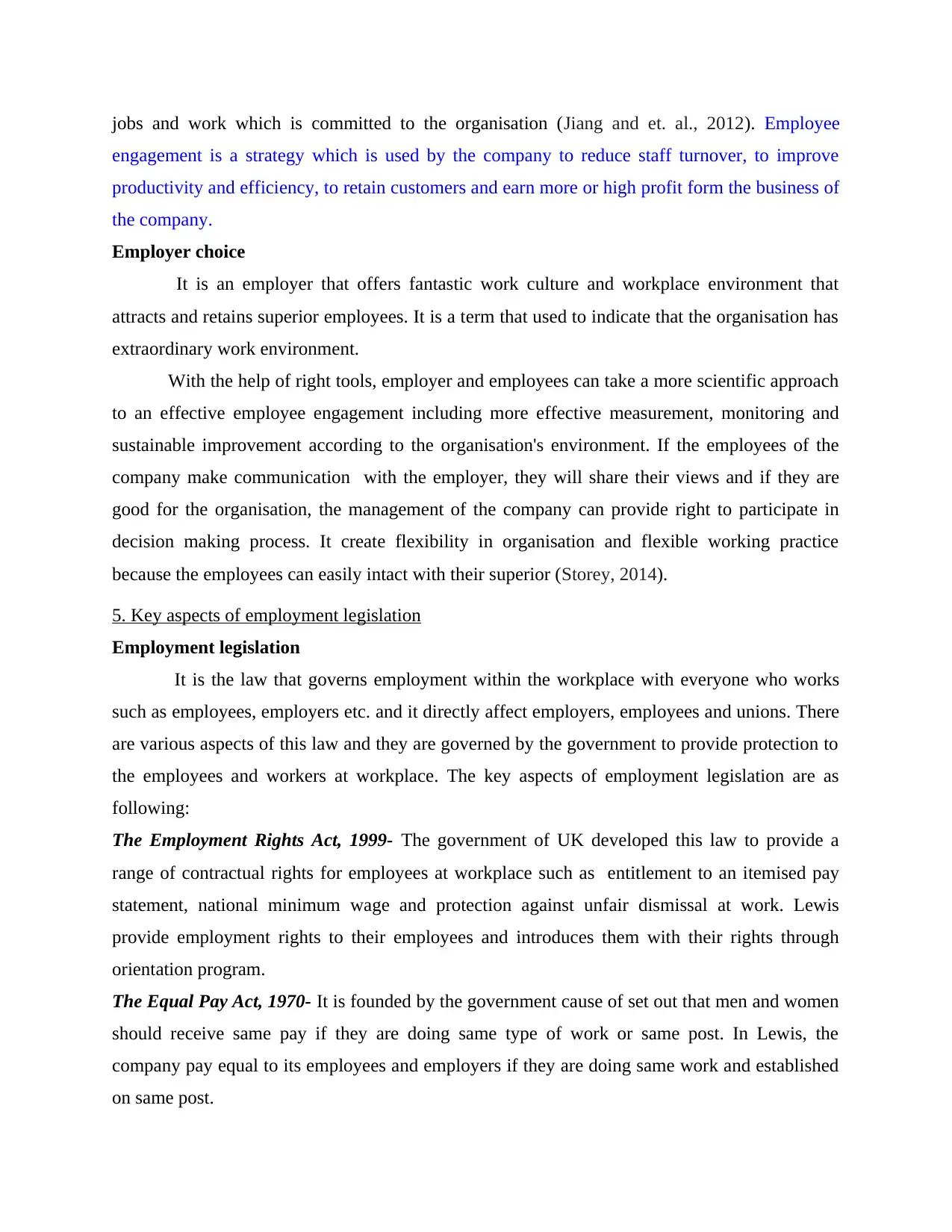
jobs and work which is committed to the organisation (Jiang and et. al., 2012). Employee
engagement is a strategy which is used by the company to reduce staff turnover, to improve
productivity and efficiency, to retain customers and earn more or high profit form the business of
the company.
Employer choice
It is an employer that offers fantastic work culture and workplace environment that
attracts and retains superior employees. It is a term that used to indicate that the organisation has
extraordinary work environment.
With the help of right tools, employer and employees can take a more scientific approach
to an effective employee engagement including more effective measurement, monitoring and
sustainable improvement according to the organisation's environment. If the employees of the
company make communication with the employer, they will share their views and if they are
good for the organisation, the management of the company can provide right to participate in
decision making process. It create flexibility in organisation and flexible working practice
because the employees can easily intact with their superior (Storey, 2014).
5. Key aspects of employment legislation
Employment legislation
It is the law that governs employment within the workplace with everyone who works
such as employees, employers etc. and it directly affect employers, employees and unions. There
are various aspects of this law and they are governed by the government to provide protection to
the employees and workers at workplace. The key aspects of employment legislation are as
following:
The Employment Rights Act, 1999- The government of UK developed this law to provide a
range of contractual rights for employees at workplace such as entitlement to an itemised pay
statement, national minimum wage and protection against unfair dismissal at work. Lewis
provide employment rights to their employees and introduces them with their rights through
orientation program.
The Equal Pay Act, 1970- It is founded by the government cause of set out that men and women
should receive same pay if they are doing same type of work or same post. In Lewis, the
company pay equal to its employees and employers if they are doing same work and established
on same post.
engagement is a strategy which is used by the company to reduce staff turnover, to improve
productivity and efficiency, to retain customers and earn more or high profit form the business of
the company.
Employer choice
It is an employer that offers fantastic work culture and workplace environment that
attracts and retains superior employees. It is a term that used to indicate that the organisation has
extraordinary work environment.
With the help of right tools, employer and employees can take a more scientific approach
to an effective employee engagement including more effective measurement, monitoring and
sustainable improvement according to the organisation's environment. If the employees of the
company make communication with the employer, they will share their views and if they are
good for the organisation, the management of the company can provide right to participate in
decision making process. It create flexibility in organisation and flexible working practice
because the employees can easily intact with their superior (Storey, 2014).
5. Key aspects of employment legislation
Employment legislation
It is the law that governs employment within the workplace with everyone who works
such as employees, employers etc. and it directly affect employers, employees and unions. There
are various aspects of this law and they are governed by the government to provide protection to
the employees and workers at workplace. The key aspects of employment legislation are as
following:
The Employment Rights Act, 1999- The government of UK developed this law to provide a
range of contractual rights for employees at workplace such as entitlement to an itemised pay
statement, national minimum wage and protection against unfair dismissal at work. Lewis
provide employment rights to their employees and introduces them with their rights through
orientation program.
The Equal Pay Act, 1970- It is founded by the government cause of set out that men and women
should receive same pay if they are doing same type of work or same post. In Lewis, the
company pay equal to its employees and employers if they are doing same work and established
on same post.
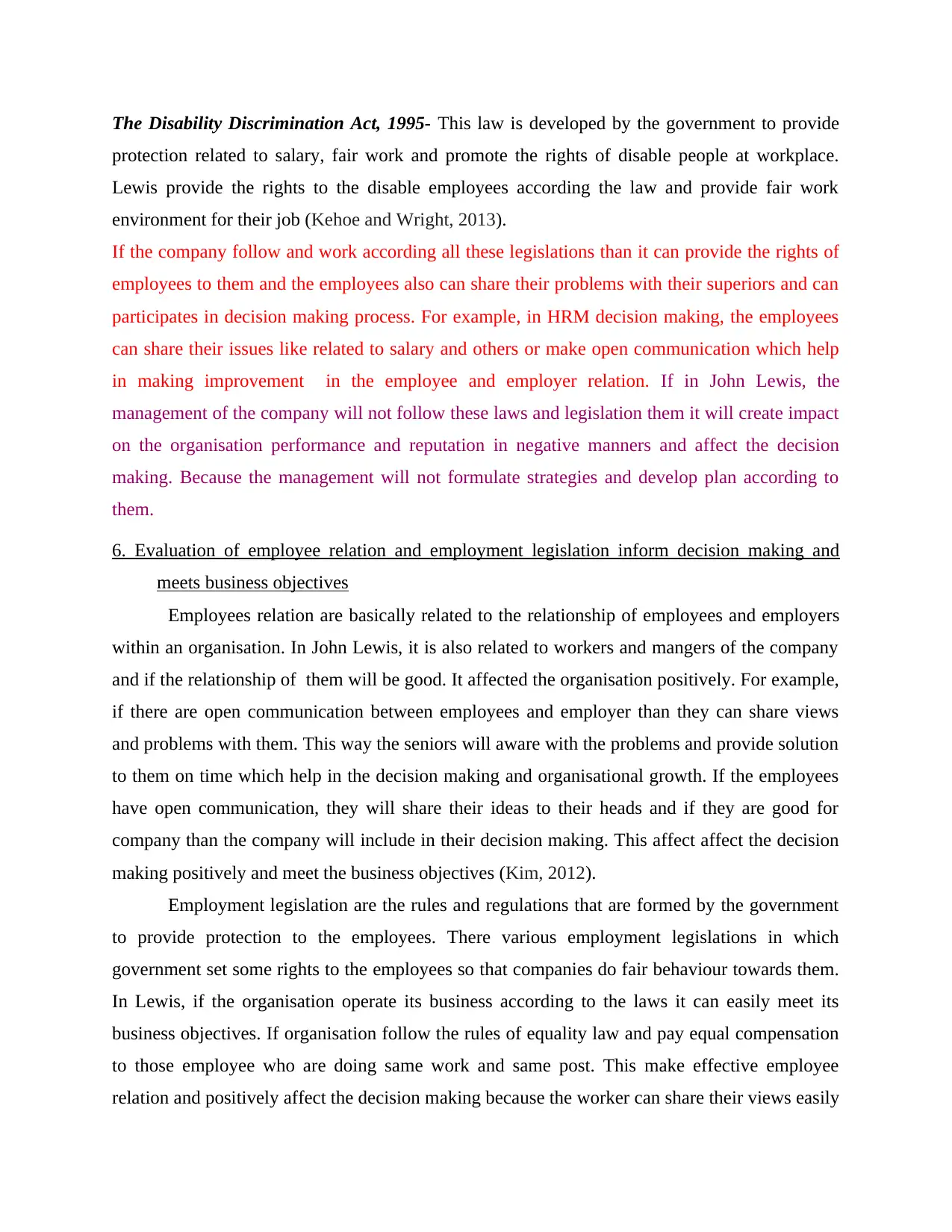
The Disability Discrimination Act, 1995- This law is developed by the government to provide
protection related to salary, fair work and promote the rights of disable people at workplace.
Lewis provide the rights to the disable employees according the law and provide fair work
environment for their job (Kehoe and Wright, 2013).
If the company follow and work according all these legislations than it can provide the rights of
employees to them and the employees also can share their problems with their superiors and can
participates in decision making process. For example, in HRM decision making, the employees
can share their issues like related to salary and others or make open communication which help
in making improvement in the employee and employer relation. If in John Lewis, the
management of the company will not follow these laws and legislation them it will create impact
on the organisation performance and reputation in negative manners and affect the decision
making. Because the management will not formulate strategies and develop plan according to
them.
6. Evaluation of employee relation and employment legislation inform decision making and
meets business objectives
Employees relation are basically related to the relationship of employees and employers
within an organisation. In John Lewis, it is also related to workers and mangers of the company
and if the relationship of them will be good. It affected the organisation positively. For example,
if there are open communication between employees and employer than they can share views
and problems with them. This way the seniors will aware with the problems and provide solution
to them on time which help in the decision making and organisational growth. If the employees
have open communication, they will share their ideas to their heads and if they are good for
company than the company will include in their decision making. This affect affect the decision
making positively and meet the business objectives (Kim, 2012).
Employment legislation are the rules and regulations that are formed by the government
to provide protection to the employees. There various employment legislations in which
government set some rights to the employees so that companies do fair behaviour towards them.
In Lewis, if the organisation operate its business according to the laws it can easily meet its
business objectives. If organisation follow the rules of equality law and pay equal compensation
to those employee who are doing same work and same post. This make effective employee
relation and positively affect the decision making because the worker can share their views easily
protection related to salary, fair work and promote the rights of disable people at workplace.
Lewis provide the rights to the disable employees according the law and provide fair work
environment for their job (Kehoe and Wright, 2013).
If the company follow and work according all these legislations than it can provide the rights of
employees to them and the employees also can share their problems with their superiors and can
participates in decision making process. For example, in HRM decision making, the employees
can share their issues like related to salary and others or make open communication which help
in making improvement in the employee and employer relation. If in John Lewis, the
management of the company will not follow these laws and legislation them it will create impact
on the organisation performance and reputation in negative manners and affect the decision
making. Because the management will not formulate strategies and develop plan according to
them.
6. Evaluation of employee relation and employment legislation inform decision making and
meets business objectives
Employees relation are basically related to the relationship of employees and employers
within an organisation. In John Lewis, it is also related to workers and mangers of the company
and if the relationship of them will be good. It affected the organisation positively. For example,
if there are open communication between employees and employer than they can share views
and problems with them. This way the seniors will aware with the problems and provide solution
to them on time which help in the decision making and organisational growth. If the employees
have open communication, they will share their ideas to their heads and if they are good for
company than the company will include in their decision making. This affect affect the decision
making positively and meet the business objectives (Kim, 2012).
Employment legislation are the rules and regulations that are formed by the government
to provide protection to the employees. There various employment legislations in which
government set some rights to the employees so that companies do fair behaviour towards them.
In Lewis, if the organisation operate its business according to the laws it can easily meet its
business objectives. If organisation follow the rules of equality law and pay equal compensation
to those employee who are doing same work and same post. This make effective employee
relation and positively affect the decision making because the worker can share their views easily
Paraphrase This Document
Need a fresh take? Get an instant paraphrase of this document with our AI Paraphraser
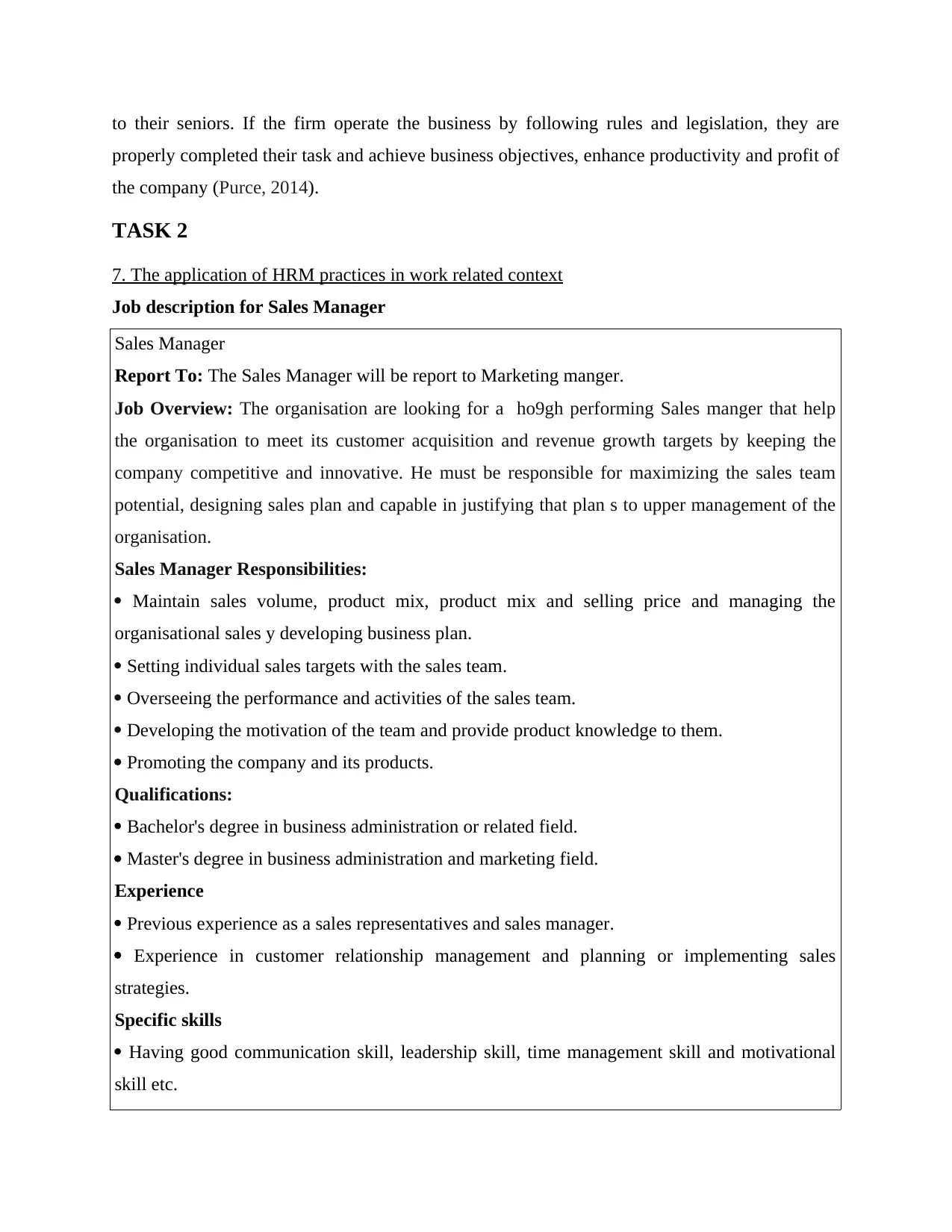
to their seniors. If the firm operate the business by following rules and legislation, they are
properly completed their task and achieve business objectives, enhance productivity and profit of
the company (Purce, 2014).
TASK 2
7. The application of HRM practices in work related context
Job description for Sales Manager
Sales Manager
Report To: The Sales Manager will be report to Marketing manger.
Job Overview: The organisation are looking for a ho9gh performing Sales manger that help
the organisation to meet its customer acquisition and revenue growth targets by keeping the
company competitive and innovative. He must be responsible for maximizing the sales team
potential, designing sales plan and capable in justifying that plan s to upper management of the
organisation.
Sales Manager Responsibilities:
Maintain sales volume, product mix, product mix and selling price and managing the
organisational sales y developing business plan.
Setting individual sales targets with the sales team.
Overseeing the performance and activities of the sales team.
Developing the motivation of the team and provide product knowledge to them.
Promoting the company and its products.
Qualifications:
Bachelor's degree in business administration or related field.
Master's degree in business administration and marketing field.
Experience
Previous experience as a sales representatives and sales manager.
Experience in customer relationship management and planning or implementing sales
strategies.
Specific skills
Having good communication skill, leadership skill, time management skill and motivational
skill etc.
properly completed their task and achieve business objectives, enhance productivity and profit of
the company (Purce, 2014).
TASK 2
7. The application of HRM practices in work related context
Job description for Sales Manager
Sales Manager
Report To: The Sales Manager will be report to Marketing manger.
Job Overview: The organisation are looking for a ho9gh performing Sales manger that help
the organisation to meet its customer acquisition and revenue growth targets by keeping the
company competitive and innovative. He must be responsible for maximizing the sales team
potential, designing sales plan and capable in justifying that plan s to upper management of the
organisation.
Sales Manager Responsibilities:
Maintain sales volume, product mix, product mix and selling price and managing the
organisational sales y developing business plan.
Setting individual sales targets with the sales team.
Overseeing the performance and activities of the sales team.
Developing the motivation of the team and provide product knowledge to them.
Promoting the company and its products.
Qualifications:
Bachelor's degree in business administration or related field.
Master's degree in business administration and marketing field.
Experience
Previous experience as a sales representatives and sales manager.
Experience in customer relationship management and planning or implementing sales
strategies.
Specific skills
Having good communication skill, leadership skill, time management skill and motivational
skill etc.
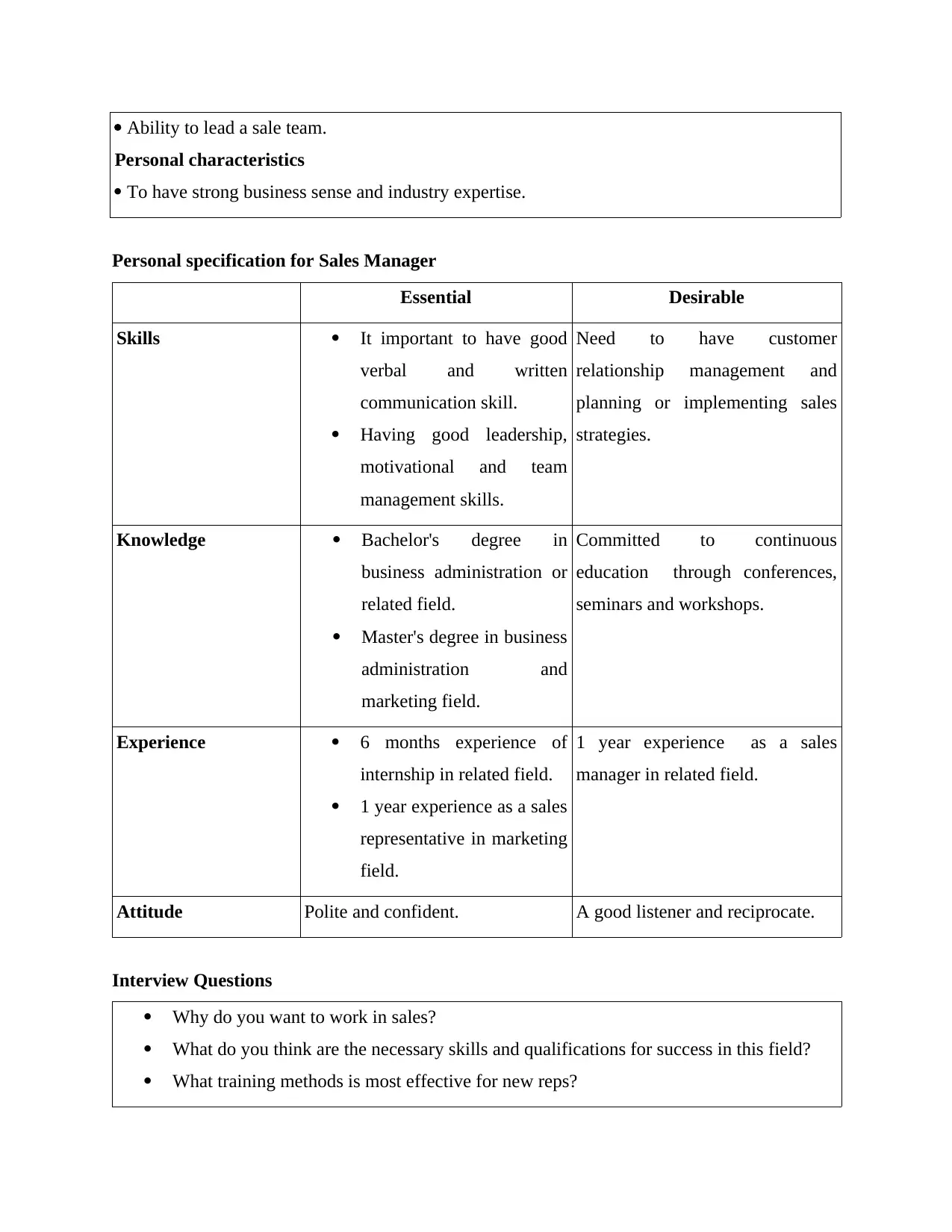
Ability to lead a sale team.
Personal characteristics
To have strong business sense and industry expertise.
Personal specification for Sales Manager
Essential Desirable
Skills It important to have good
verbal and written
communication skill.
Having good leadership,
motivational and team
management skills.
Need to have customer
relationship management and
planning or implementing sales
strategies.
Knowledge Bachelor's degree in
business administration or
related field.
Master's degree in business
administration and
marketing field.
Committed to continuous
education through conferences,
seminars and workshops.
Experience 6 months experience of
internship in related field.
1 year experience as a sales
representative in marketing
field.
1 year experience as a sales
manager in related field.
Attitude Polite and confident. A good listener and reciprocate.
Interview Questions
Why do you want to work in sales?
What do you think are the necessary skills and qualifications for success in this field?
What training methods is most effective for new reps?
Personal characteristics
To have strong business sense and industry expertise.
Personal specification for Sales Manager
Essential Desirable
Skills It important to have good
verbal and written
communication skill.
Having good leadership,
motivational and team
management skills.
Need to have customer
relationship management and
planning or implementing sales
strategies.
Knowledge Bachelor's degree in
business administration or
related field.
Master's degree in business
administration and
marketing field.
Committed to continuous
education through conferences,
seminars and workshops.
Experience 6 months experience of
internship in related field.
1 year experience as a sales
representative in marketing
field.
1 year experience as a sales
manager in related field.
Attitude Polite and confident. A good listener and reciprocate.
Interview Questions
Why do you want to work in sales?
What do you think are the necessary skills and qualifications for success in this field?
What training methods is most effective for new reps?
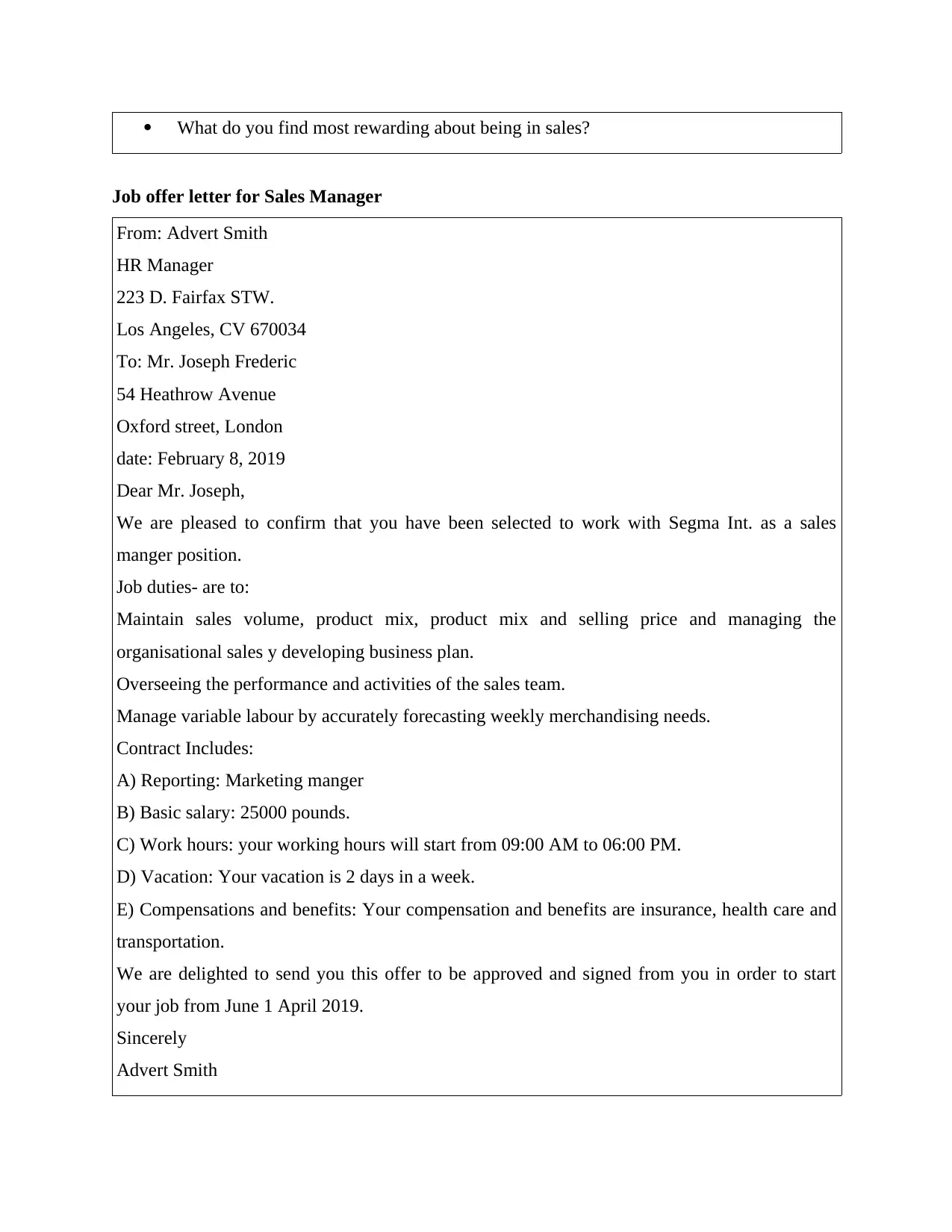
What do you find most rewarding about being in sales?
Job offer letter for Sales Manager
From: Advert Smith
HR Manager
223 D. Fairfax STW.
Los Angeles, CV 670034
To: Mr. Joseph Frederic
54 Heathrow Avenue
Oxford street, London
date: February 8, 2019
Dear Mr. Joseph,
We are pleased to confirm that you have been selected to work with Segma Int. as a sales
manger position.
Job duties- are to:
Maintain sales volume, product mix, product mix and selling price and managing the
organisational sales y developing business plan.
Overseeing the performance and activities of the sales team.
Manage variable labour by accurately forecasting weekly merchandising needs.
Contract Includes:
A) Reporting: Marketing manger
B) Basic salary: 25000 pounds.
C) Work hours: your working hours will start from 09:00 AM to 06:00 PM.
D) Vacation: Your vacation is 2 days in a week.
E) Compensations and benefits: Your compensation and benefits are insurance, health care and
transportation.
We are delighted to send you this offer to be approved and signed from you in order to start
your job from June 1 April 2019.
Sincerely
Advert Smith
Job offer letter for Sales Manager
From: Advert Smith
HR Manager
223 D. Fairfax STW.
Los Angeles, CV 670034
To: Mr. Joseph Frederic
54 Heathrow Avenue
Oxford street, London
date: February 8, 2019
Dear Mr. Joseph,
We are pleased to confirm that you have been selected to work with Segma Int. as a sales
manger position.
Job duties- are to:
Maintain sales volume, product mix, product mix and selling price and managing the
organisational sales y developing business plan.
Overseeing the performance and activities of the sales team.
Manage variable labour by accurately forecasting weekly merchandising needs.
Contract Includes:
A) Reporting: Marketing manger
B) Basic salary: 25000 pounds.
C) Work hours: your working hours will start from 09:00 AM to 06:00 PM.
D) Vacation: Your vacation is 2 days in a week.
E) Compensations and benefits: Your compensation and benefits are insurance, health care and
transportation.
We are delighted to send you this offer to be approved and signed from you in order to start
your job from June 1 April 2019.
Sincerely
Advert Smith
Secure Best Marks with AI Grader
Need help grading? Try our AI Grader for instant feedback on your assignments.
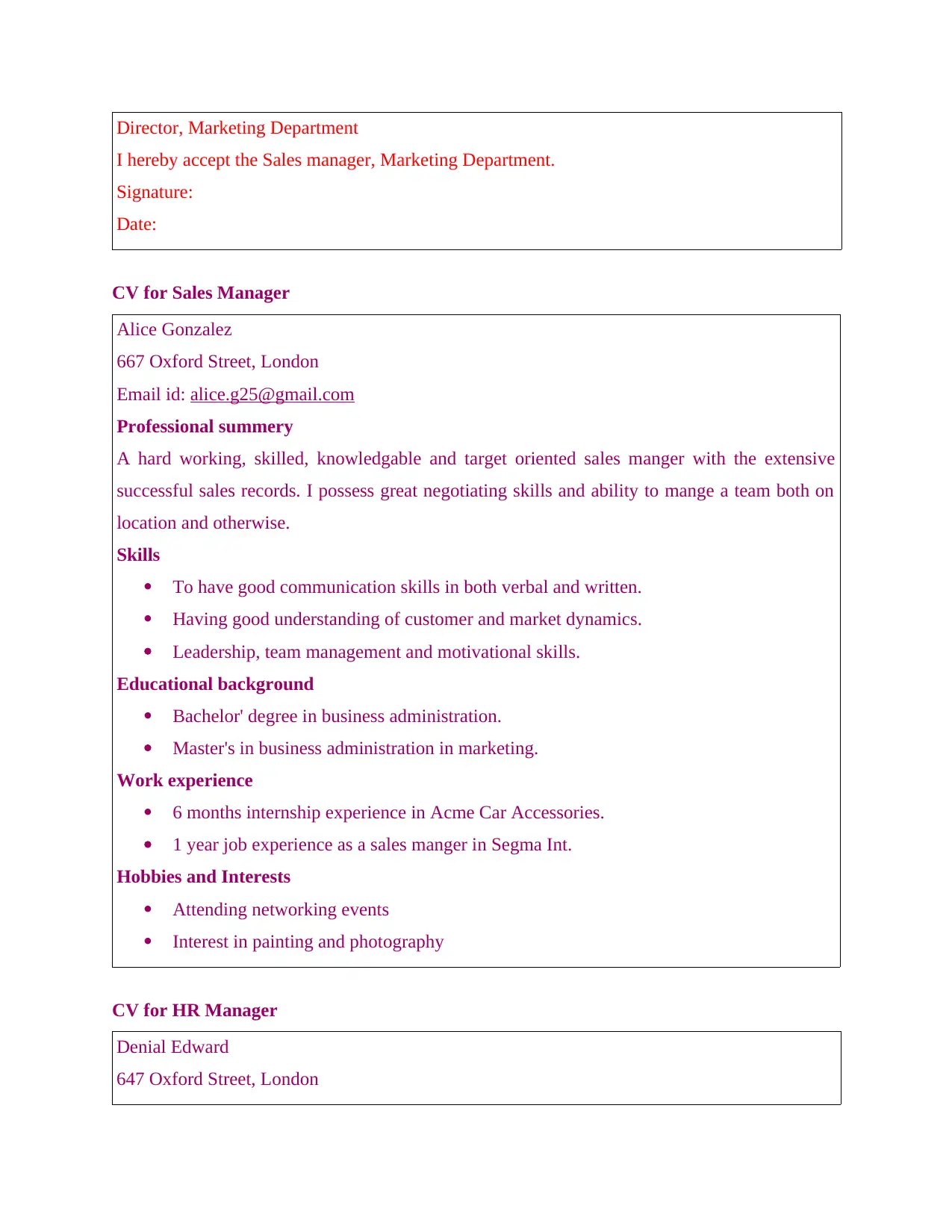
Director, Marketing Department
I hereby accept the Sales manager, Marketing Department.
Signature:
Date:
CV for Sales Manager
Alice Gonzalez
667 Oxford Street, London
Email id: alice.g25@gmail.com
Professional summery
A hard working, skilled, knowledgable and target oriented sales manger with the extensive
successful sales records. I possess great negotiating skills and ability to mange a team both on
location and otherwise.
Skills
To have good communication skills in both verbal and written.
Having good understanding of customer and market dynamics.
Leadership, team management and motivational skills.
Educational background
Bachelor' degree in business administration.
Master's in business administration in marketing.
Work experience
6 months internship experience in Acme Car Accessories.
1 year job experience as a sales manger in Segma Int.
Hobbies and Interests
Attending networking events
Interest in painting and photography
CV for HR Manager
Denial Edward
647 Oxford Street, London
I hereby accept the Sales manager, Marketing Department.
Signature:
Date:
CV for Sales Manager
Alice Gonzalez
667 Oxford Street, London
Email id: alice.g25@gmail.com
Professional summery
A hard working, skilled, knowledgable and target oriented sales manger with the extensive
successful sales records. I possess great negotiating skills and ability to mange a team both on
location and otherwise.
Skills
To have good communication skills in both verbal and written.
Having good understanding of customer and market dynamics.
Leadership, team management and motivational skills.
Educational background
Bachelor' degree in business administration.
Master's in business administration in marketing.
Work experience
6 months internship experience in Acme Car Accessories.
1 year job experience as a sales manger in Segma Int.
Hobbies and Interests
Attending networking events
Interest in painting and photography
CV for HR Manager
Denial Edward
647 Oxford Street, London
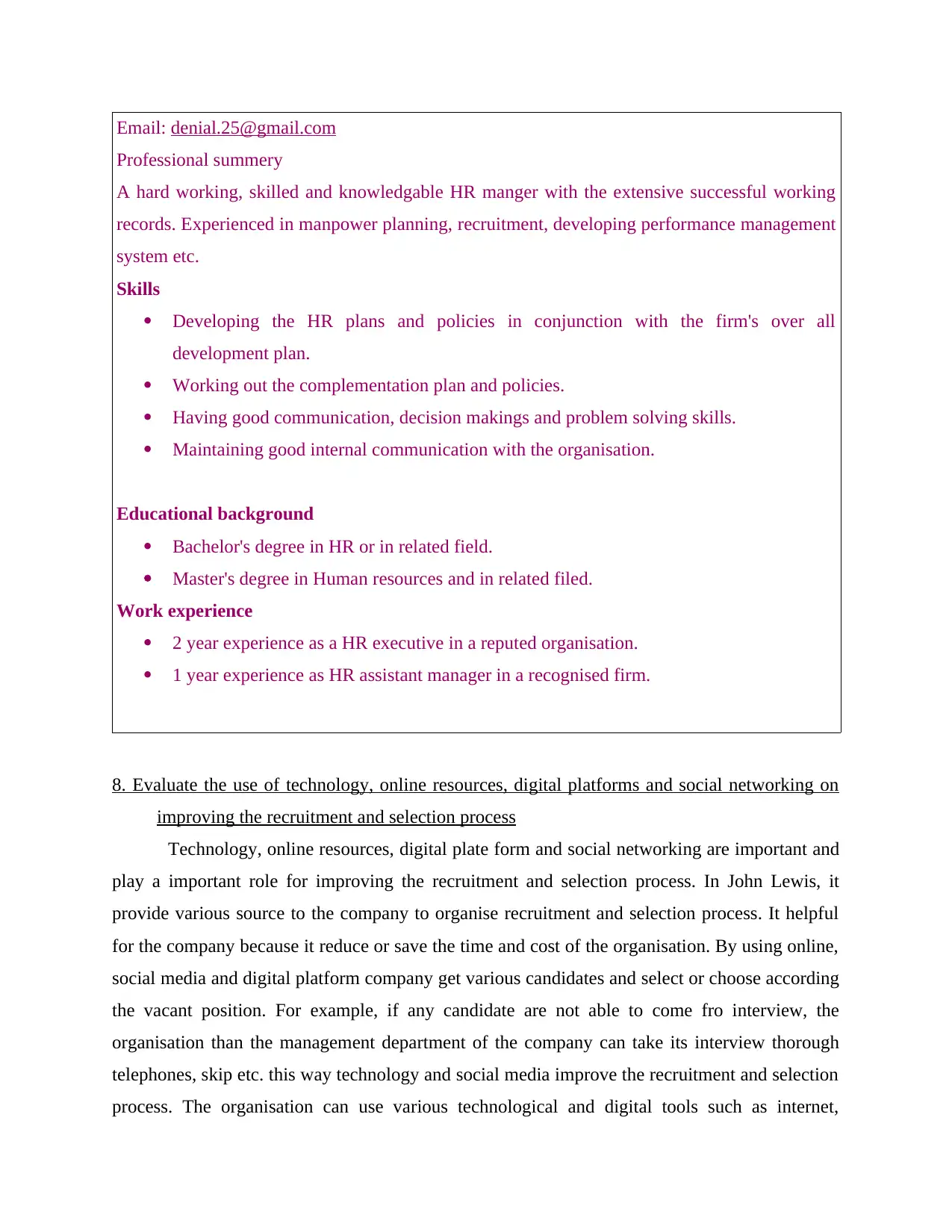
Email: denial.25@gmail.com
Professional summery
A hard working, skilled and knowledgable HR manger with the extensive successful working
records. Experienced in manpower planning, recruitment, developing performance management
system etc.
Skills
Developing the HR plans and policies in conjunction with the firm's over all
development plan.
Working out the complementation plan and policies.
Having good communication, decision makings and problem solving skills.
Maintaining good internal communication with the organisation.
Educational background
Bachelor's degree in HR or in related field.
Master's degree in Human resources and in related filed.
Work experience
2 year experience as a HR executive in a reputed organisation.
1 year experience as HR assistant manager in a recognised firm.
8. Evaluate the use of technology, online resources, digital platforms and social networking on
improving the recruitment and selection process
Technology, online resources, digital plate form and social networking are important and
play a important role for improving the recruitment and selection process. In John Lewis, it
provide various source to the company to organise recruitment and selection process. It helpful
for the company because it reduce or save the time and cost of the organisation. By using online,
social media and digital platform company get various candidates and select or choose according
the vacant position. For example, if any candidate are not able to come fro interview, the
organisation than the management department of the company can take its interview thorough
telephones, skip etc. this way technology and social media improve the recruitment and selection
process. The organisation can use various technological and digital tools such as internet,
Professional summery
A hard working, skilled and knowledgable HR manger with the extensive successful working
records. Experienced in manpower planning, recruitment, developing performance management
system etc.
Skills
Developing the HR plans and policies in conjunction with the firm's over all
development plan.
Working out the complementation plan and policies.
Having good communication, decision makings and problem solving skills.
Maintaining good internal communication with the organisation.
Educational background
Bachelor's degree in HR or in related field.
Master's degree in Human resources and in related filed.
Work experience
2 year experience as a HR executive in a reputed organisation.
1 year experience as HR assistant manager in a recognised firm.
8. Evaluate the use of technology, online resources, digital platforms and social networking on
improving the recruitment and selection process
Technology, online resources, digital plate form and social networking are important and
play a important role for improving the recruitment and selection process. In John Lewis, it
provide various source to the company to organise recruitment and selection process. It helpful
for the company because it reduce or save the time and cost of the organisation. By using online,
social media and digital platform company get various candidates and select or choose according
the vacant position. For example, if any candidate are not able to come fro interview, the
organisation than the management department of the company can take its interview thorough
telephones, skip etc. this way technology and social media improve the recruitment and selection
process. The organisation can use various technological and digital tools such as internet,
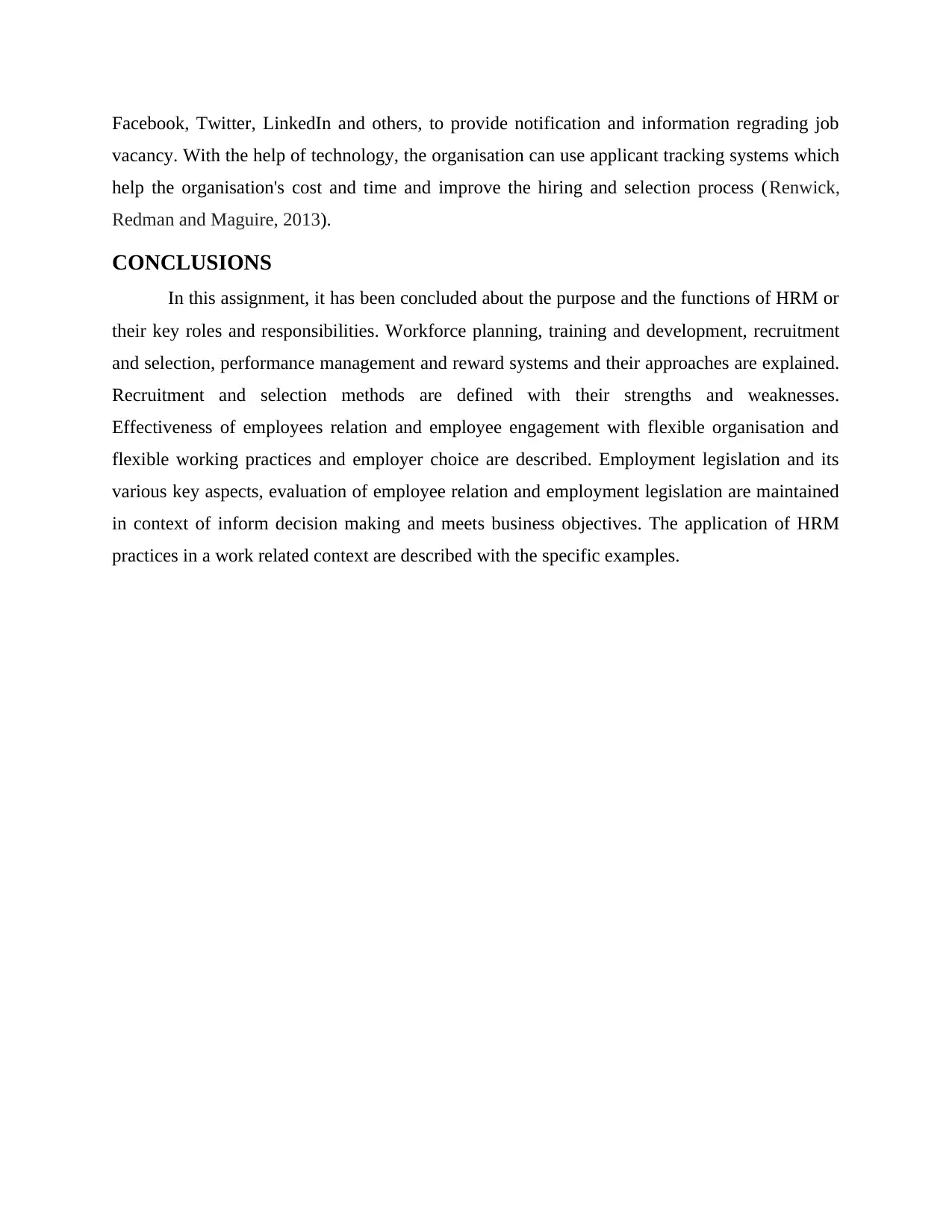
Facebook, Twitter, LinkedIn and others, to provide notification and information regrading job
vacancy. With the help of technology, the organisation can use applicant tracking systems which
help the organisation's cost and time and improve the hiring and selection process (Renwick,
Redman and Maguire, 2013).
CONCLUSIONS
In this assignment, it has been concluded about the purpose and the functions of HRM or
their key roles and responsibilities. Workforce planning, training and development, recruitment
and selection, performance management and reward systems and their approaches are explained.
Recruitment and selection methods are defined with their strengths and weaknesses.
Effectiveness of employees relation and employee engagement with flexible organisation and
flexible working practices and employer choice are described. Employment legislation and its
various key aspects, evaluation of employee relation and employment legislation are maintained
in context of inform decision making and meets business objectives. The application of HRM
practices in a work related context are described with the specific examples.
vacancy. With the help of technology, the organisation can use applicant tracking systems which
help the organisation's cost and time and improve the hiring and selection process (Renwick,
Redman and Maguire, 2013).
CONCLUSIONS
In this assignment, it has been concluded about the purpose and the functions of HRM or
their key roles and responsibilities. Workforce planning, training and development, recruitment
and selection, performance management and reward systems and their approaches are explained.
Recruitment and selection methods are defined with their strengths and weaknesses.
Effectiveness of employees relation and employee engagement with flexible organisation and
flexible working practices and employer choice are described. Employment legislation and its
various key aspects, evaluation of employee relation and employment legislation are maintained
in context of inform decision making and meets business objectives. The application of HRM
practices in a work related context are described with the specific examples.
Paraphrase This Document
Need a fresh take? Get an instant paraphrase of this document with our AI Paraphraser
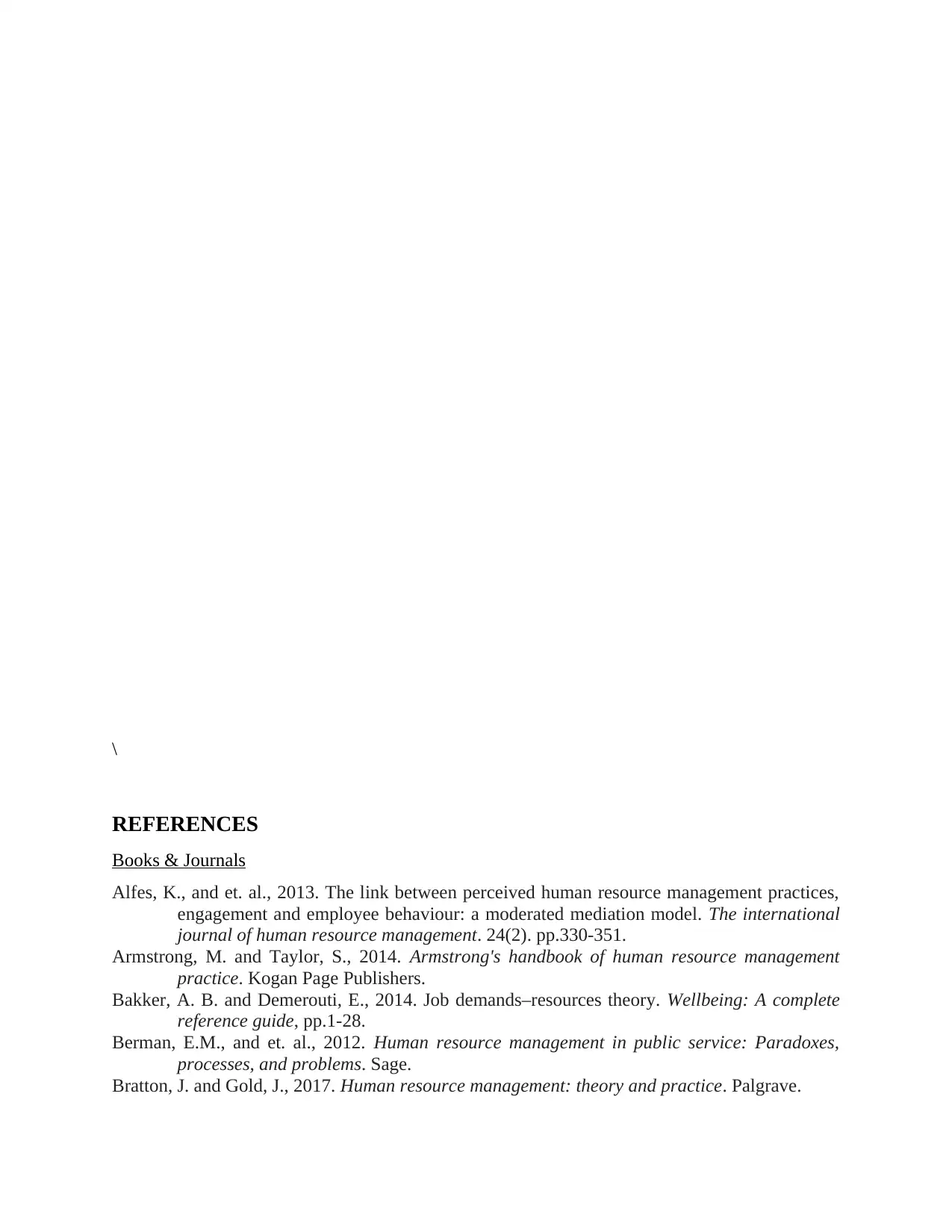
\
REFERENCES
Books & Journals
Alfes, K., and et. al., 2013. The link between perceived human resource management practices,
engagement and employee behaviour: a moderated mediation model. The international
journal of human resource management. 24(2). pp.330-351.
Armstrong, M. and Taylor, S., 2014. Armstrong's handbook of human resource management
practice. Kogan Page Publishers.
Bakker, A. B. and Demerouti, E., 2014. Job demands–resources theory. Wellbeing: A complete
reference guide, pp.1-28.
Berman, E.M., and et. al., 2012. Human resource management in public service: Paradoxes,
processes, and problems. Sage.
Bratton, J. and Gold, J., 2017. Human resource management: theory and practice. Palgrave.
REFERENCES
Books & Journals
Alfes, K., and et. al., 2013. The link between perceived human resource management practices,
engagement and employee behaviour: a moderated mediation model. The international
journal of human resource management. 24(2). pp.330-351.
Armstrong, M. and Taylor, S., 2014. Armstrong's handbook of human resource management
practice. Kogan Page Publishers.
Bakker, A. B. and Demerouti, E., 2014. Job demands–resources theory. Wellbeing: A complete
reference guide, pp.1-28.
Berman, E.M., and et. al., 2012. Human resource management in public service: Paradoxes,
processes, and problems. Sage.
Bratton, J. and Gold, J., 2017. Human resource management: theory and practice. Palgrave.

Buller, P. F. and McEvoy, G. M., 2012. Strategy, human resource management and performance:
Sharpening line of sight. Human resource management review. 22(1). pp.43-56.
Gatewood, R., Feild, H.S . and Barrick, M., 2015. Human resource selection. Nelson Education.
Glendon, A. I. and Clarke, S., 2015. Human safety and risk management: A psychological
perspective. Crc Press.
Jackson, S. E., Schuler, R. S. and Jiang, K., 2014. An aspirational framework for strategic human
resource management. The Academy of Management Annals. 8(1). pp.1-56.
Jiang, K., and et. al., 2012. Clarifying the construct of human resource systems: Relating human
resource management to employee performance. Human resource management review.
22(2). pp.73-85.
Jiang, K., and et. al., 2012. How does human resource management influence organizational
outcomes? A meta-analytic investigation of mediating mechanisms. Academy of
management Journal. 55(6). pp.1264-1294.
Kehoe, R. R. and Wright, P. M., 2013. The impact of high-performance human resource
practices on employees’ attitudes and behaviors. Journal of management. 39(2). pp.366-
391.
Kim, S., 2012. The impact of human resource management on state government IT employee
turnover intentions. Public Personnel Management. 41(2). pp.257-279.
Purce, J., 2014. The impact of corporate strategy on human resource management. New
Perspectives on Human Resource Management (Routledge Revivals). 67.
Renwick, D. W., Redman, T. and Maguire, S., 2013. Green human resource management: A
review and research agenda. International Journal of Management Reviews. 15(1). pp.1-
14.
Storey, J., 2014. New Perspectives on Human Resource Management (Routledge Revivals).
Routledge.
Online
Functions of Human Resource. 2018. [Online]. Available Through: <https://bizfluent.com/info-
8244762-six-functions-human-resource-department.html>.
Sharpening line of sight. Human resource management review. 22(1). pp.43-56.
Gatewood, R., Feild, H.S . and Barrick, M., 2015. Human resource selection. Nelson Education.
Glendon, A. I. and Clarke, S., 2015. Human safety and risk management: A psychological
perspective. Crc Press.
Jackson, S. E., Schuler, R. S. and Jiang, K., 2014. An aspirational framework for strategic human
resource management. The Academy of Management Annals. 8(1). pp.1-56.
Jiang, K., and et. al., 2012. Clarifying the construct of human resource systems: Relating human
resource management to employee performance. Human resource management review.
22(2). pp.73-85.
Jiang, K., and et. al., 2012. How does human resource management influence organizational
outcomes? A meta-analytic investigation of mediating mechanisms. Academy of
management Journal. 55(6). pp.1264-1294.
Kehoe, R. R. and Wright, P. M., 2013. The impact of high-performance human resource
practices on employees’ attitudes and behaviors. Journal of management. 39(2). pp.366-
391.
Kim, S., 2012. The impact of human resource management on state government IT employee
turnover intentions. Public Personnel Management. 41(2). pp.257-279.
Purce, J., 2014. The impact of corporate strategy on human resource management. New
Perspectives on Human Resource Management (Routledge Revivals). 67.
Renwick, D. W., Redman, T. and Maguire, S., 2013. Green human resource management: A
review and research agenda. International Journal of Management Reviews. 15(1). pp.1-
14.
Storey, J., 2014. New Perspectives on Human Resource Management (Routledge Revivals).
Routledge.
Online
Functions of Human Resource. 2018. [Online]. Available Through: <https://bizfluent.com/info-
8244762-six-functions-human-resource-department.html>.
1 out of 18
Related Documents
Your All-in-One AI-Powered Toolkit for Academic Success.
+13062052269
info@desklib.com
Available 24*7 on WhatsApp / Email
![[object Object]](/_next/static/media/star-bottom.7253800d.svg)
Unlock your academic potential
© 2024 | Zucol Services PVT LTD | All rights reserved.





